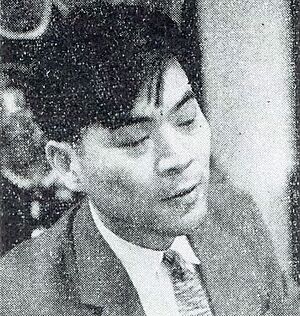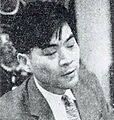Takaaki Yoshimoto facts for kids
Quick facts for kids
Takaaki Yoshimoto
|
|
|---|---|
| 吉本隆明 | |

Yoshimoto in 1960
|
|
| Born | November 25, 1924 Tsukishima, Tokyo
|
| Died | March 16, 2012 (aged 87) Bunkyō, Tokyo
|
| Nationality | Japanese |
| Other names | Ryūmei Yoshimoto |
| Alma mater | Tokyo Institute of Technology |
| Occupation | Poet, philosopher, literary critic |
| Years active | 1952 – 2012 |
Takaaki Yoshimoto (吉本 隆明, Yoshimoto Takaaki, 25 November 1924 – 16 March 2012), also known as Ryūmei Yoshimoto, was an important Japanese poet, philosopher, and literary critic. A philosopher is someone who studies big ideas about life and knowledge. A literary critic analyzes and judges books and other writings.
Yoshimoto is remembered for helping to start the New Left in Japan, which was a new way of thinking about politics. He also pushed writers to think about their role during wartime.
Takaaki Yoshimoto was the father of famous Japanese writer Banana Yoshimoto and cartoonist Yoiko Haruno.
Contents
Early Life and Education
Yoshimoto was born in 1924 in Tsukishima, Tokyo. He was the third son in a family that built boats. His family had moved to Tokyo from Kumamoto prefecture, on the southern island of Kyushu, just before he was born.
As a teenager, Yoshimoto became very interested in literature and started writing poetry. He was inspired by poets like Takamura Kōtarō and Miyazawa Kenji. During World War II, he was a young person who supported the military. However, after the war ended, he became very interested in Marxism, which is a way of thinking about society and economics.
Yoshimoto went to Tashima Elementary School in Tokyo. He later studied at Yonezawa Engineering School and graduated from the Engineering Division of Tokyo Institute of Technology in 1947. He earned a degree in Electrochemistry, which is about how electricity and chemical reactions work together. During his studies, he became friends with literary critic Takeo Okuno.
After college, Yoshimoto worked in industry. In 1952, he started working at Tokyo Ink Manufacturing Company Ltd. He continued to write poetry and published important works like Dialogue with Particularity. He also won an award for new poets.
Influence on the New Left Movement
Takaaki Yoshimoto believed that writers and intellectuals had a responsibility to speak out about the war. He supported the Anpo Protests in 1960. These protests were against a new security treaty between the United States and Japan. Many people felt this treaty went against Japan's new peaceful ways after the war.
Yoshimoto strongly opposed the treaty. He became a big supporter of the Zengakuren student activists, who were leading the protests. He gave speeches to the students and even joined them in their protests. For example, he participated in a sit-in at Shinagawa Station in Tokyo and joined students who entered the National Diet (Japan's parliament) compound. He encouraged them to keep protesting.
After a clash with police where a student named Michiko Kanba died, Yoshimoto was arrested. He was questioned for three days but was later released.
New Ideas After the Protests
The protests did not stop the treaty from being approved. This made Yoshimoto feel angry and disappointed with the older political groups on the left. In October 1960, he wrote an important essay called “The End of Fictions.” In this essay, he said that the protests showed that both the ruling party and the established left-wing groups were not being honest.
Yoshimoto believed that the only way forward was for individuals to be truly independent and free. He called this "absolute individual autonomy."
In 1961, Yoshimoto helped start a magazine called Experiment (Shikkō). This magazine was a place for people to publish essays and criticism without being controlled by any big organization. It featured articles by writers who had been critical of the Communist Party.
Becoming a "Prophet" for Students
Throughout the 1960s, Yoshimoto became a hero to the new student activists. They called him the “prophet” of the New Left. Students liked that Yoshimoto was developing new ideas when older political groups were struggling. His books became very popular, especially his 1962 essay collection, also called The End of Fictions.
In his writings, Yoshimoto developed new ideas about art and language. He also introduced the idea of "communal fantasy" (共同幻想, kyōdō gensō). This describes how groups of people can be swept up by shared ideas, like how propaganda and militarism led many people in Japan to support the war.
Yoshimoto's ideas about radical individualism (focusing on the importance of each person's freedom) became very popular. They offered a different path for students and thinkers who were tired of the old, strict political ideas. His philosophy influenced student groups like Zengakuren and Zenkyoto in the 1960s and 1970s. His books were considered essential reading for students involved in the 1968–69 Japanese university protests.
Even though he was influential, Yoshimoto stayed somewhat separate from the student protests of the late 1960s. He didn't like groups that were too strict or controlled by a single party. He eventually felt that even the new student groups were still part of a "communal fantasy," similar to what had led Japan into World War II.
Later Years and Works
Starting in the 1980s, Yoshimoto wrote about "the masses" (large groups of people) and "the city." Around this time, he appeared in a women's magazine called AnAn wearing clothes by a famous designer. Some critics said he was "wearing capitalism itself," meaning he was becoming too supportive of big business.
After this, Yoshimoto did become more politically conservative. He even supported a politician named Ichirō Ozawa.
In the late 1980s, Yoshimoto criticized movements against nuclear power and nuclear weapons. He called them "Anti-Nuclear Fascism," which meant he thought they were too extreme.
In the 1990s, Yoshimoto made comments about the yoga practices of Asahara Shoko, the leader of Aum Shinrikyo. He said they showed the true meaning of early Buddhist practices. Because of these comments, he was criticized by some people.
In August 1996, Yoshimoto had a serious health scare when he fell unconscious while swimming, but he recovered. After the mid-1990s, his writing style became more informal, like personal essays.
In 2003, he won the Kobayashi Hideo Prize for his book Reading Natsume Sōseki. His collected works also received another award, the Fujimura Memorial prize.
Images for kids


